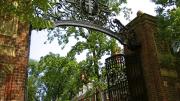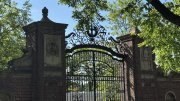The revolting late-winter reports about wealthy parents paying to cheat on their children’s standardized tests and bribing coaches to get their high-schoolers listed as athletic recruits—and thus into institutions such as the University of Southern California and Yale—seem an unfortunate, totemic spectacle for our times. (For a separate complication involving a Harvard coach, see here.) All the elements are there: shameless status-seeking; the sense of entitlement associated with wealth, and emphatically divorced from merit; and the yawning disparities of means (and accompanying lack of morals among some who possess them) in twenty-first-century America. Readers can rank the details in order of sordidness, but they surely include the perpetrator’s device of making the conduit for the money seem like a legitimate nonprofit, so “clients” could write-off their bribes as charitable deductions, or “bill” for them as business expenses. Thanks, guys.
Unfortunately, the overwhelming majority of selective-admissions colleges and universities that were not victimized by the scam are not wholly isolated from its spreading stain. Consider:
- From the time he was appointed Harvard’s president, in February 2018, Lawrence S. Bacow has emphasized the critical importance of regaining public trust in higher education, at a time of unprecedented skepticism about the value of college and, in some quarters, the perceived values expressed on campuses. As reported (“In the Public Arena,” January-February, page 26), many critiques of college today reflect a conservative perspective: that campuses are hothouses for liberalism, and intolerant of conservative voices. More broadly, citizens are concerned about, and put off by, the costs of earning a degree. That sentiment has been exacerbated in the past decade by reduced state budget support for public institutions, forcing them to increase tuitions and fees sharply. (The overwhelming majority of students attend institutions that, unlike Harvard and other top-tier private schools, are not significantly endowed and cannot offer substantial financial aid—so the rising sticker price has shocked most families.)
- In this context, the testimony in Students for Fair Admissions’ lawsuit against the University detailed admission preferences associated with athletic ability and applicants’ legacy status (“Admissions on Trial,” January-February, page 15). Surveys reveal that the citizenry, which overwhelmingly opposes affirmative-action considerations in holistic reviews of applicants, strongly dislikes athletic and donor/legacy preferences, too. The public is very meat-and-potatoes on admissions: merit, as measured by grades and test scores, is the meal of choice.
- Now, the admissions scandal has revealed the so-called “side door” of faking athletic credentials to gain preferential access to admissions, for those with the means (and ethical deficits) willing to do so.
The resulting perfect storm threatens to deepen public antipathy toward elite institutions—and to broaden its partisan contours in ways unhelpful to their stated agendas.
Even before the scandal made headlines, the think tank New America published “Supporting Students of Color in Higher Education,” in response to a query from four U.S. senators (two of them declared candidates for the Democratic presidential nomination). In offering “our insights about protecting and empowering students of color to ensure they have equitable access to high-quality, affordable educational opportunities after high school” (the point of affirmative action, by the way), the authors advocated
- ending federal financial aid for “highly-resourced and highly-selective institutions that engage in legacy admissions and other preferential admissions treatments that overwhelmingly favor wealthy and white families, including early decision programs” and
- requiring lottery-based admissions processes among “highly-selective colleges and universities that want access to federal research dollars.”
Radical and far-reaching as those proposals might be, even in their authors’ view, they hint at a change in the wind. In mid March, Ron Wyden (D-Oregon), ranking minority member of the Senate Finance Committee, announced that he would introduce legislation ending the tax benefit for donations made to colleges and universites before or during the enrollment of children of the donor’s family. And at the end of that month, California legislators proposed bills that would ban universities, public or private, that receive state scholarship funding from giving legacy or donor preferences in admissions, and would require multiple institutional officers to authorize special admissions (for any candidate who does not meet academic requirements). And congressional interest in forcing institutions to devote more of their endowment income to enroll and support lower-income students continues to percolate.
In other words, on the left, the taint of elite access is eroding support for the otherwise evident benefits of higher education as an economic stepping stone. In a report on these matters, The Chronicle of Higher Education cited pollster and Democratic campaign strategist Jill Normington’s finding that the white working class—46 percent of the adult population—is shifting from its historic support of policies to expand access to college to a very different perspective: that perhaps college is not for everyone. While that no doubt reflects concerns about costs and postgraduate employment prospects, the shift could easily be accelerated by the widening perception that admissions are yet another example of a society and institutions rigged for rich insiders.
This is tragic, in socioeconomic terms. The evidence about the benefits of attaining a college degree is greater than ever.
From the perspective of higher-education institutions, their leaders, and their extended constituencies, the political challenge, already large, looms larger in the wake of the admissions scandal. Addressing the deep-rooted public skepticism likely means going beyond public relations and enhanced outreach to substantive change: reconsidering some long-held practices and, yes, preferences about the attributes that count in admissions to selective schools.
* * *
Humble pie. No sooner had the previous edition of this column—grousing in part about the lack of academic and intellectual discourse in Faculty of Arts and Sciences meetings—gone to press in early April (“No more pencils, no more books…,” May-June, page 8) than the April 2 gathering vigorously debated what exactly students should know about quantitative reasoning. The conversation, continuing similar exchanges from 2006-2007 and 2015-2016 considerations of the College’s General Education curriculum, and unresolved then, got to some very basic ideas about data-infused, twenty-first-century learning and teaching. Whether the solution legislated May 7, for implementation this fall, proves wise, or satisfactory, remains to be seen. But the talk was good to hear.
~ John S. Rosenberg, Editor








